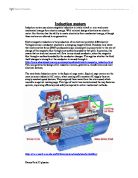When a squirrel cage motor is used with a three-phase power source, it forms the simplest electric motor. This motor is made up of three fixed coils around a rotating shaft which consists of a core filled with a series of conductors set up in a circle pattern around the shaft. With the three-phase current flowing through the coils a rotating magnetic field is produced, the field then induces a current in the conductors on the shaft. This is where three-phase power outperforms single phase. For the shaft to rotate smoothly without stopping the three coils situated at 120° from each other are supplied with power at precise intervals. This can be better described by the graphics below.
(http://engr.calvin.edu/courses/engr204/2000/examples/ThreePhase/theory.html)
As you can see AC power follows a perfect sine curve, and three phase power uses three phases and introduces them at a constant time interval. Each sine curve peaks at a constant interval and this interval is what is used to supply the coils with power at different times to successfully create a rotating magnetic field.
()
This diagram depicts a three phase induction motor; it is visible from this diagram how the coils are supplied with power at exact intervals in order to create a rotating magnetic field. This diagram also portrays further advantages of the AC induction motor, there are no brushes meaning no wear and no sparks.
The reaction between the magnetic field and the conductors makes the rotor turn. The rotor must not rotate at the same rate of the magnetic field or there will be no current produced within the conductors, under normal running conditions the rotor and the magnetic field have a difference or ‘slip’ of 2 to 5 percent, the shaft must rotate slower than the magnetic field in order for the motor to operate correctly. The torque of the motor is generally governed by the amount of slip the motor has.
The speed of an induction motor like this was originally only changeable by means of having coils or conductors that could be added or switched off. Although with recent technology developments the speed can be changed much more accurately and smoother by changing the frequency of the AC current that is charging the coils.
The squirrel cage motor can is also extremely useful in the domestic household. Although there is one major drawback, in this environment single phase power is primarily used because of the relatively low power needs. This does not however, rule out the use of induction motors within the home.
Since single phase power resembles only a single sine curve it us much more difficult to create a rotating magnetic field. The diagram below shows how there are four coils used to induce a rotating EMF. This is done by using capacitors to alter the time interval in which the coils are supplied power. Simple capacitors consist of two plates made of an electrically conducting material (e.g., a metal) and separated by a non-conducting material or dielectric (e.g., glass, paraffin, mica, oil, paper, tantalum, or air).
Another drawback of using induction motors on single phase is that they are not self starting. When the motor is connected to a single phase power supply, the main winding carries an alternating current. This current produces a pulsating magnetic field. Due to induction, the rotor is energized. As the main magnetic field is pulsating, the torque necessary for the motor rotation is not generated. This will cause the rotor to simply vibrate, but not rotate. Therefore induction motors on single phase must have a starting mechanism. This starting mechanism is generally a series capacitor or a centrifugal switch. When current is initially applied the capacitor at the beginning of the circuit creates a high voltage at this point and a low at the end point, this creates a power ‘surge’ in the first coil that is not equal to the others, resulting in an EMF rotating in a single direction. Once the motor reaches about 75% of its rated speed a centrifugal switch disconnects the starter. From this point on the motor can produce enough torque to operate on its own. As capacitors of high voltage rating are very expensive this method is generally only used in engines up to ¾ hp.
The AC induction motor is one of the most basic and common motors in use today.
Physics concepts such as what has been discussed are integral parts of today’s lifestyle, these concepts have revolutionized the way we live.
Bibliography
AC circuits [Online], Available from:
(Accessed 9 May)
Electric Motors [Online], Available from:
, (Accessed 9 May 2005)
Electric Motor [Online], Available from:
, (Accessed 17 May 2005)
Electric Motors and Generators [Online], Available from:
, (Accessed 17 May 2005)
Induction Motors [Online], Available from:
, (Accessed 17 May 2005)
Induction Motors [Online], Available from:
, (Accessed 18 May 2005)
Three phase power [Online], Available from:
, (Accessed 17 May 2005)







